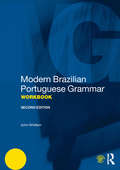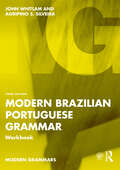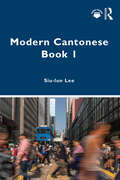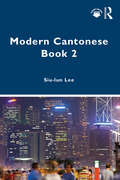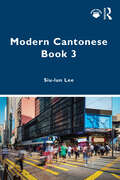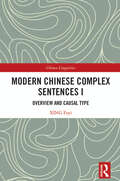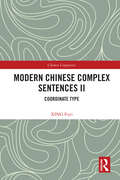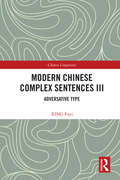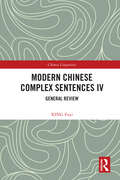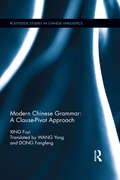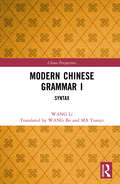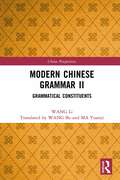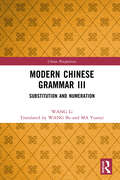- Table View
- List View
Modern Brazilian Portuguese Grammar Workbook (Modern Grammar Workbooks)
by John WhitlamThe second edition of Modern Brazilian Portuguese Grammar Workbook is an innovative book of exercises and language tasks for all learners of Brazilian Portuguese. The book is divided into two sections: • Part A provides exercises based on essential grammatical structures • Part B practises everyday functions (e.g. making social contact, asking questions and expressing needs). A comprehensive answer key at the back of the book enables you to check on your progress. The Modern Brazilian Portuguese Grammar Workbook is ideal for all learners who have a basic knowledge of Brazilian Portuguese, including undergraduates taking Brazilian Portuguese as a major or minor part of their studies, as well as intermediate and advanced school, adult education and self-study students. While primarily intended for use in conjunction with Modern Brazilian Portuguese Grammar: A Practical Guide, it can also serve as an independent resource.
Modern Brazilian Portuguese Grammar Workbook: Their Foundations In Popular And Learned Culture, 1300-1500 (Modern Grammar Workbooks)
by John WhitlamThe second edition of Modern Brazilian Portuguese Grammar Workbook is an innovative book of exercises and language tasks for all learners of Brazilian Portuguese. The book is divided into two sections: • Part A provides exercises based on essential grammatical structures • Part B practises everyday functions (e.g. making social contact, asking questions and expressing needs). A comprehensive answer key at the back of the book enables you to check on your progress. The Modern Brazilian Portuguese Grammar Workbook is ideal for all learners who have a basic knowledge of Brazilian Portuguese, including undergraduates taking Brazilian Portuguese as a major or minor part of their studies, as well as intermediate and advanced school, adult education and self-study students. While primarily intended for use in conjunction with Modern Brazilian Portuguese Grammar: A Practical Guide, it can also serve as an independent resource.
Modern Brazilian Portuguese Grammar Workbook (Modern Grammar Workbooks)
by John Whitlam Agripino S. SilveiraModern Brazilian Portuguese Grammar Workbook is an innovative book of exercises and language tasks for all learners of Brazilian Portuguese, ideal for use alongside the Modern Brazilian Portuguese Grammar or as an independent resource. The book is divided into two sections. Part A provides exercises based on essential grammatical structures whilst Part B practises everyday functions, including making social contact, asking questions and expressing needs. This third edition offers a greater variety of exercises, including exercises designed to practice concepts introduced in the "Notes for Spanish Speakers" sections of the Grammar. Exercises from the second edition have also been revised and expanded upon and a comprehensive answer key at the back of the book enables you to check on your progress. The Modern Brazilian Portuguese Grammar Workbook is ideal for all learners who have a basic knowledge of Brazilian Portuguese, including undergraduates taking Brazilian Portuguese as a major or minor part of their studies, as well as intermediate and advanced school, adult education and self-study students.
Modern Brazilian Portuguese Grammar Workbook (Modern Grammar Workbooks)
by John Whitlam Agripino S. SilveiraModern Brazilian Portuguese Grammar Workbook is an innovative book of exercises and language tasks for all learners of Brazilian Portuguese, ideal for use alongside the Modern Brazilian Portuguese Grammar or as an independent resource. The book is divided into two sections. Part A provides exercises based on essential grammatical structures whilst Part B practises everyday functions, including making social contact, asking questions and expressing needs. This third edition offers a greater variety of exercises, including exercises designed to practice concepts introduced in the "Notes for Spanish Speakers" sections of the Grammar. Exercises from the second edition have also been revised and expanded upon and a comprehensive answer key at the back of the book enables you to check on your progress. The Modern Brazilian Portuguese Grammar Workbook is ideal for all learners who have a basic knowledge of Brazilian Portuguese, including undergraduates taking Brazilian Portuguese as a major or minor part of their studies, as well as intermediate and advanced school, adult education and self-study students.
Modern Cantonese Book 1: A textbook for global learners
by Siu-lun LeeThe first volume of Modern Cantonese aims to provide solid linguistic training to beginner Cantonese learners, highlighting cultural points with lively language scenarios. This book provides daily conversational scenarios, such as introducing yourself and others, ordering food, going out with friends, shopping, planning a weekend, and talking about hobbies and leisure activities, as well as holidays and festivals. The scenarios cover daily settings with essential learning points, and on completion of the course, learners will be able to understand questions and statements in Cantonese conversations and will be able to discuss familiar everyday topics using simple sentences in Cantonese. The book is ideal for students seeking to learn Cantonese as a second language at the novice level, based on ACTFL speaking proficiency guidelines. It may also be of interest to language teachers and linguists in the field of Cantonese as a second language.
Modern Cantonese Book 1: A textbook for global learners
by Siu-lun LeeThe first volume of Modern Cantonese aims to provide solid linguistic training to beginner Cantonese learners, highlighting cultural points with lively language scenarios. This book provides daily conversational scenarios, such as introducing yourself and others, ordering food, going out with friends, shopping, planning a weekend, and talking about hobbies and leisure activities, as well as holidays and festivals. The scenarios cover daily settings with essential learning points, and on completion of the course, learners will be able to understand questions and statements in Cantonese conversations and will be able to discuss familiar everyday topics using simple sentences in Cantonese. The book is ideal for students seeking to learn Cantonese as a second language at the novice level, based on ACTFL speaking proficiency guidelines. It may also be of interest to language teachers and linguists in the field of Cantonese as a second language.
Modern Cantonese Book 2: A textbook for global learners
by Siu-lun LeeThe second volume of Modern Cantonese aims to facilitate learners in understanding the main ideas expressed in conversations and discussions, as well as exchanging information. This book is structured around situational scenarios, which cover informal and semi-formal settings in daily activities and work-related situations. After completing this volume, learners will be able to understand conversations and discussions relating to a range of activities in Hong Kong, Macau, and Shenzhen. This book is targeted at intermediate learners of Cantonese, while language teachers and linguists interested in Cantonese as a second language may also find it informative.
Modern Cantonese Book 2: A textbook for global learners
by Siu-lun LeeThe second volume of Modern Cantonese aims to facilitate learners in understanding the main ideas expressed in conversations and discussions, as well as exchanging information. This book is structured around situational scenarios, which cover informal and semi-formal settings in daily activities and work-related situations. After completing this volume, learners will be able to understand conversations and discussions relating to a range of activities in Hong Kong, Macau, and Shenzhen. This book is targeted at intermediate learners of Cantonese, while language teachers and linguists interested in Cantonese as a second language may also find it informative.
Modern Cantonese Book 3: A textbook for global learners
by Siu-lun LeeThe third volume of Modern Cantonese aims to broaden learners’ Cantonese language skills by teaching students how to deal with, discuss, persuade, and summarize topics related to sophisticated work-related situations. This book provides scenarios talking about abstract topics, as well as cultural and social issues in both formal and semi-formal settings. Learners gain the skills to discuss a variety of complex topics and abstract issues. This book is designed for intermediate to advanced learners who have reached Intermediate Mid (ACTFL) or B1 (CEFR) proficiency. Language teachers, linguists, and researchers interested in Cantonese as a second Language may also find the book informative.
Modern Cantonese Book 3: A textbook for global learners
by Siu-lun LeeThe third volume of Modern Cantonese aims to broaden learners’ Cantonese language skills by teaching students how to deal with, discuss, persuade, and summarize topics related to sophisticated work-related situations. This book provides scenarios talking about abstract topics, as well as cultural and social issues in both formal and semi-formal settings. Learners gain the skills to discuss a variety of complex topics and abstract issues. This book is designed for intermediate to advanced learners who have reached Intermediate Mid (ACTFL) or B1 (CEFR) proficiency. Language teachers, linguists, and researchers interested in Cantonese as a second Language may also find the book informative.
Modern Chinese Complex Sentences I: Overview and Causal Type (Chinese Linguistics)
by XING FuyiThis book is the first of a four-volume set on modern Chinese complex sentences, and is focused on the overall characteristics and the casual complex sentences in the language in particular. Complex sentences in modern Chinese are unique in information and meaning. The author proposes a tripartite classification of Chinese complex sentences according to the semantic relationships between the clauses, that is, coordinated, causal, and adversative. The first part of this volume defines Chinese complex sentences, introduces the properties, scope, and functions of complex sentence relationship markers, and makes detailed comparisons between the tripartite and dichotomous systems for the classification of complex sentences. The second part thoroughly investigates causal complex sentences in their eight typical forms. The book will be a useful reference for scholars and learners interested in Chinese grammar and language information processing.
Modern Chinese Complex Sentences I: Overview and Causal Type (Chinese Linguistics)
by XING FuyiThis book is the first of a four-volume set on modern Chinese complex sentences, and is focused on the overall characteristics and the casual complex sentences in the language in particular. Complex sentences in modern Chinese are unique in information and meaning. The author proposes a tripartite classification of Chinese complex sentences according to the semantic relationships between the clauses, that is, coordinated, causal, and adversative. The first part of this volume defines Chinese complex sentences, introduces the properties, scope, and functions of complex sentence relationship markers, and makes detailed comparisons between the tripartite and dichotomous systems for the classification of complex sentences. The second part thoroughly investigates causal complex sentences in their eight typical forms. The book will be a useful reference for scholars and learners interested in Chinese grammar and language information processing.
Modern Chinese Complex Sentences II: Coordinate Type (Chinese Linguistics)
by XING FuyiThis book is the second volume of a four-volume set on modern Chinese complex sentences, with a focus on coordinate complex sentences and their relevant forms.Complex sentences in modern Chinese are unique in formation and meaning. The author proposes a tripartite classification of Chinese complex sentences according to the semantic relationships between the clauses, that is, coordinate, causal, and adversative. This volume analyzes the coordinated type in the broad sense and the relevant forms, including the representative form in which the clauses are juxtaposed with each other, paired and single occurrences of the connective yībiān, and various forms of successive, progressive, and alternative complex sentences, as well as the compound forms.The book will be a useful reference for scholars and learners interested in Chinese grammar and language information processing.
Modern Chinese Complex Sentences II: Coordinate Type (Chinese Linguistics)
by XING FuyiThis book is the second volume of a four-volume set on modern Chinese complex sentences, with a focus on coordinate complex sentences and their relevant forms.Complex sentences in modern Chinese are unique in formation and meaning. The author proposes a tripartite classification of Chinese complex sentences according to the semantic relationships between the clauses, that is, coordinate, causal, and adversative. This volume analyzes the coordinated type in the broad sense and the relevant forms, including the representative form in which the clauses are juxtaposed with each other, paired and single occurrences of the connective yībiān, and various forms of successive, progressive, and alternative complex sentences, as well as the compound forms.The book will be a useful reference for scholars and learners interested in Chinese grammar and language information processing.
Modern Chinese Complex Sentences III: Adversative Type (Chinese Linguistics)
by XING FuyiThis book is the third volume of a four-volume set on modern Chinese complex sentences, with a focus on adversative complex sentences and relevant forms.Complex sentences in modern Chinese are unique in formation and meaning. The author proposes a tripartite classification of Chinese complex sentences according to the semantic relationships between the clauses, i.e., coordinate, causal, and adversative. This volume analyzes representative forms of adversative type, including the prototype, the clauses linked by connectives referring to otherwise, the combinations of clause structures and certain adversative conjunctions or linking adverbs indicating an adversative relationship, the adversative factors and relationship in two typical progressive structures, factive sentences and concessive forms. It also discusses the adversative type in the broad sense, classifying the different forms and also analyzing the semantic meaning, pragmatic value, and implications for research and language teaching.The book will be a useful reference for scholars and learners of the Chinese language interested in Chinese grammar and language information processing.
Modern Chinese Complex Sentences III: Adversative Type (Chinese Linguistics)
by XING FuyiThis book is the third volume of a four-volume set on modern Chinese complex sentences, with a focus on adversative complex sentences and relevant forms.Complex sentences in modern Chinese are unique in formation and meaning. The author proposes a tripartite classification of Chinese complex sentences according to the semantic relationships between the clauses, i.e., coordinate, causal, and adversative. This volume analyzes representative forms of adversative type, including the prototype, the clauses linked by connectives referring to otherwise, the combinations of clause structures and certain adversative conjunctions or linking adverbs indicating an adversative relationship, the adversative factors and relationship in two typical progressive structures, factive sentences and concessive forms. It also discusses the adversative type in the broad sense, classifying the different forms and also analyzing the semantic meaning, pragmatic value, and implications for research and language teaching.The book will be a useful reference for scholars and learners of the Chinese language interested in Chinese grammar and language information processing.
Modern Chinese Complex Sentences IV: General Review (Chinese Linguistics)
by XING FuyiThis book is the final volume of a four-volume set on modern Chinese complex sentences, assessing the key attributes, related sentence structures, and semantic and pragmatic relevance of complex sentences. Complex sentences in modern Chinese are unique in formation and meaning. Following on from analysis on coordinate, causal and adversative types of complex sentences, the ten chapters in this volume review the characteristics of complex sentences as a whole. The author discusses the constituents, related structures, semantic and pragmatic aspects of complex sentences, covering topics such as the constraints and counter-constraints between sentence forms and semantic relationships, six type-crossover markers, distinctions between simple sentences and complex sentences, clauses formed by a noun/nominal phrase followed by le, the shǐ-structure, subject ellipsis or tacit understanding of clauses, as well as double-subject sentences, alternative question groups and their relationships withcomplex sentences. The book will be a useful reference for scholars and learners interested in Chinese grammar and language information processing.
Modern Chinese Complex Sentences IV: General Review (Chinese Linguistics)
by XING FuyiThis book is the final volume of a four-volume set on modern Chinese complex sentences, assessing the key attributes, related sentence structures, and semantic and pragmatic relevance of complex sentences. Complex sentences in modern Chinese are unique in formation and meaning. Following on from analysis on coordinate, causal and adversative types of complex sentences, the ten chapters in this volume review the characteristics of complex sentences as a whole. The author discusses the constituents, related structures, semantic and pragmatic aspects of complex sentences, covering topics such as the constraints and counter-constraints between sentence forms and semantic relationships, six type-crossover markers, distinctions between simple sentences and complex sentences, clauses formed by a noun/nominal phrase followed by le, the shǐ-structure, subject ellipsis or tacit understanding of clauses, as well as double-subject sentences, alternative question groups and their relationships withcomplex sentences. The book will be a useful reference for scholars and learners interested in Chinese grammar and language information processing.
Modern Chinese Grammar - a Clause-Pivot Approach: A Clause-Pivot Theoretical Approach (Routledge Studies in Chinese Linguistics)
by Fuyi XingModern Chinese Grammar provides a comprehensive coverage of Chinese grammar through the clause-pivot theory and the double triangle approach, first proposed by Fuyi Xing in 1996. Translated into English for the first time, the book is widely regarded by linguists as a seminal text, and ground-breaking in linguistics research. The book contains discussion of the topics which are essential to Chinese grammar, from words and phrases, to complex sentences and sentence groups. It addresses such controversial issues as word class identification, the distinction between words and phrases, and between clauses and complex sentences. The book also shows, through a wealth of examples, how the clause-pivot theory and the double triangle approach can be applied productively in grammatical studies. Modern Chinese Grammar: A Clause-Pivot Theoretical Approach is an essential purchase for researchers and graduate students of Chinese grammar and syntax.
Modern Chinese Grammar - a Clause-Pivot Approach: A Clause-Pivot Theoretical Approach (Routledge Studies in Chinese Linguistics)
by Fuyi XingModern Chinese Grammar provides a comprehensive coverage of Chinese grammar through the clause-pivot theory and the double triangle approach, first proposed by Fuyi Xing in 1996. Translated into English for the first time, the book is widely regarded by linguists as a seminal text, and ground-breaking in linguistics research. The book contains discussion of the topics which are essential to Chinese grammar, from words and phrases, to complex sentences and sentence groups. It addresses such controversial issues as word class identification, the distinction between words and phrases, and between clauses and complex sentences. The book also shows, through a wealth of examples, how the clause-pivot theory and the double triangle approach can be applied productively in grammatical studies. Modern Chinese Grammar: A Clause-Pivot Theoretical Approach is an essential purchase for researchers and graduate students of Chinese grammar and syntax.
Modern Chinese Grammar I: Syntax (China Perspectives)
by WANG LiFocusing on the fundamental grammatical units and construction in modern Chinese, this title is the first volume of a classic on modern Chinese grammar by WANG Li, one of the most distinguished Chinese linguists. Based on the corpus of two classic Chinese novels and being part of a four-volume set that describes the various linguistic patterns of modern Chinese grammar, this volume first distinguishes Chinese characters from words, categorizes words into different word classes and discusses the different word classes according to the number of syllables. The complex structures, which include phrases, sentences and various grammatical constructions such as those of optative, causative, disposal, passive, annex and retrenched, are then classified and elaborated on. Drawing on Otto Jespersen’s theory, the author applies the notion of rank to construct a new framework for Chinese grammar. Including a wide variety of examples and analyses, this book is a must-read for Chinese language learners, as well as researchers and students studying Chinese linguistics and modern Chinese grammar.
Modern Chinese Grammar I: Syntax (China Perspectives)
by WANG LiFocusing on the fundamental grammatical units and construction in modern Chinese, this title is the first volume of a classic on modern Chinese grammar by WANG Li, one of the most distinguished Chinese linguists. Based on the corpus of two classic Chinese novels and being part of a four-volume set that describes the various linguistic patterns of modern Chinese grammar, this volume first distinguishes Chinese characters from words, categorizes words into different word classes and discusses the different word classes according to the number of syllables. The complex structures, which include phrases, sentences and various grammatical constructions such as those of optative, causative, disposal, passive, annex and retrenched, are then classified and elaborated on. Drawing on Otto Jespersen’s theory, the author applies the notion of rank to construct a new framework for Chinese grammar. Including a wide variety of examples and analyses, this book is a must-read for Chinese language learners, as well as researchers and students studying Chinese linguistics and modern Chinese grammar.
Modern Chinese Grammar II: Grammatical Constituents (China Perspectives)
by WANG LiFocusing on the fundamental grammatical units and construction in modern Chinese, this title is the second volume of a classic on modern Chinese grammar by WANG Li, one of the most distinguished Chinese linguists. This volume discusses nine major grammatical components in modern Chinese: 1) copulas, 2) negation, 3) adverbs, 4) markers applied to indicate the features of words or phrases, 5) aspects that indicate the duration and status of events, 6) moods that help express the emotions in language, 7) modal tertiaries, 8) connectives and 9) relative tertiaries. Including a wide variety of examples and analyses, this book is a must-read for Chinese language learners, as well as researchers and students studying Chinese linguistics and modern Chinese grammar.
Modern Chinese Grammar II: Grammatical Constituents (China Perspectives)
by WANG LiFocusing on the fundamental grammatical units and construction in modern Chinese, this title is the second volume of a classic on modern Chinese grammar by WANG Li, one of the most distinguished Chinese linguists. This volume discusses nine major grammatical components in modern Chinese: 1) copulas, 2) negation, 3) adverbs, 4) markers applied to indicate the features of words or phrases, 5) aspects that indicate the duration and status of events, 6) moods that help express the emotions in language, 7) modal tertiaries, 8) connectives and 9) relative tertiaries. Including a wide variety of examples and analyses, this book is a must-read for Chinese language learners, as well as researchers and students studying Chinese linguistics and modern Chinese grammar.
Modern Chinese Grammar III: Substitution and Numeration (China Perspectives)
by WANG LiFocusing on substitution and numeration of modern Chinese, this is the third volume of a classic on modern Chinese grammar by WANG Li, one of the most distinguished Chinese linguists. In this volume, the author first introduces the different types of pronoun, such as personal pronoun, indefinite pronoun, resumptive pronoun, demonstrative pronoun and interrogative pronoun. Methods of numeration in modern Chinese are then delineated, encompassing such perspectives as cardinal number, ordinal number and numeration system of person, thing and behavior. Including a wide variety of examples and analyses, this book is a must-read for Chinese language learners, as well as researchers and students studying Chinese linguistics and modern Chinese grammar.
